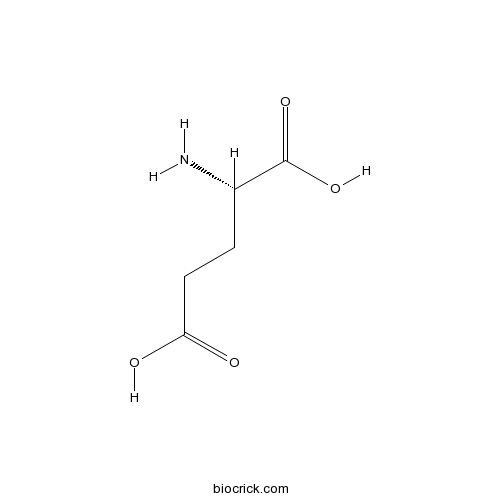L-Glutamic acidEndogenous, non-selective agonist CAS# 56-86-0 |

- H-D-Glu-OH
Catalog No.:BCC2936
CAS No.:6893-26-1
Quality Control & MSDS
3D structure
Package In Stock
Number of papers citing our products

| Cas No. | 56-86-0 | SDF | Download SDF |
| PubChem ID | 33032 | Appearance | White powder |
| Formula | C5H9NO4 | M.Wt | 147.1 |
| Type of Compound | Alkaloids | Storage | Desiccate at -20°C |
| Solubility | Soluble to 100 mM in 1eq. NaOH | ||
| Chemical Name | (2S)-2-aminopentanedioic acid | ||
| SMILES | C(CC(=O)O)C(C(=O)O)N | ||
| Standard InChIKey | WHUUTDBJXJRKMK-VKHMYHEASA-N | ||
| Standard InChI | InChI=1S/C5H9NO4/c6-3(5(9)10)1-2-4(7)8/h3H,1-2,6H2,(H,7,8)(H,9,10)/t3-/m0/s1 | ||
| General tips | For obtaining a higher solubility , please warm the tube at 37 ℃ and shake it in the ultrasonic bath for a while.Stock solution can be stored below -20℃ for several months. We recommend that you prepare and use the solution on the same day. However, if the test schedule requires, the stock solutions can be prepared in advance, and the stock solution must be sealed and stored below -20℃. In general, the stock solution can be kept for several months. Before use, we recommend that you leave the vial at room temperature for at least an hour before opening it. |
||
| About Packaging | 1. The packaging of the product may be reversed during transportation, cause the high purity compounds to adhere to the neck or cap of the vial.Take the vail out of its packaging and shake gently until the compounds fall to the bottom of the vial. 2. For liquid products, please centrifuge at 500xg to gather the liquid to the bottom of the vial. 3. Try to avoid loss or contamination during the experiment. |
||
| Shipping Condition | Packaging according to customer requirements(5mg, 10mg, 20mg and more). Ship via FedEx, DHL, UPS, EMS or other couriers with RT, or blue ice upon request. | ||
| Description | L-Glutamic acid is probably an excitatory transmitter of major significance in the mammalian central nervous system. L-Glutamic acid and L-lysine as useful building blocks for the preparation of bifunctional DTPA-like ligands. |
| Structure Identification | Nature, 1974 , 248 (5451) :804-5.Spinal interneurone excitation by conformationally restricted analogues of L-glutamic acid[Reference: WebLink]L-Glutamic acid is probably an excitatory transmitter of major significance in the mammalian central nervous system1. Bioconjug. Chem., 1999 , 10 (1) :137-40.L-Glutamic acid and L-lysine as useful building blocks for the preparation of bifunctional DTPA-like ligands.[Reference: WebLink]
|

L-Glutamic acid Dilution Calculator

L-Glutamic acid Molarity Calculator
| 1 mg | 5 mg | 10 mg | 20 mg | 25 mg | |
| 1 mM | 6.7981 mL | 33.9905 mL | 67.981 mL | 135.9619 mL | 169.9524 mL |
| 5 mM | 1.3596 mL | 6.7981 mL | 13.5962 mL | 27.1924 mL | 33.9905 mL |
| 10 mM | 0.6798 mL | 3.399 mL | 6.7981 mL | 13.5962 mL | 16.9952 mL |
| 50 mM | 0.136 mL | 0.6798 mL | 1.3596 mL | 2.7192 mL | 3.399 mL |
| 100 mM | 0.068 mL | 0.3399 mL | 0.6798 mL | 1.3596 mL | 1.6995 mL |
| * Note: If you are in the process of experiment, it's necessary to make the dilution ratios of the samples. The dilution data above is only for reference. Normally, it's can get a better solubility within lower of Concentrations. | |||||

Calcutta University

University of Minnesota

University of Maryland School of Medicine

University of Illinois at Chicago

The Ohio State University

University of Zurich

Harvard University

Colorado State University

Auburn University

Yale University

Worcester Polytechnic Institute

Washington State University

Stanford University

University of Leipzig

Universidade da Beira Interior

The Institute of Cancer Research

Heidelberg University

University of Amsterdam

University of Auckland

TsingHua University

The University of Michigan

Miami University

DRURY University

Jilin University

Fudan University

Wuhan University

Sun Yat-sen University

Universite de Paris

Deemed University

Auckland University

The University of Tokyo

Korea University
H-Glu-OH
- L-Glutamine
Catalog No.:BCC3803
CAS No.:56-85-9
- H-Asp-OH
Catalog No.:BCC2881
CAS No.:56-84-8
- Glycerol
Catalog No.:BCC8990
CAS No.:56-81-5
- Chloramphenicol
Catalog No.:BCC1201
CAS No.:56-75-7
- DL-5-Hydroxytryptophan
Catalog No.:BCN1232
CAS No.:56-69-9
- Quinidine
Catalog No.:BCC7863
CAS No.:56-54-2
- Diethylstilbestrol
Catalog No.:BCC4900
CAS No.:56-53-1
- Deoxycorticosterone acetate
Catalog No.:BCC4655
CAS No.:56-47-3
- H-Ser-OH
Catalog No.:BCC3028
CAS No.:56-45-1
- H-Ala-OH
Catalog No.:BCC3190
CAS No.:56-41-7
- H-Gly-OH
Catalog No.:BCC2946
CAS No.:56-40-6
- Tetraethylammonium chloride
Catalog No.:BCC7554
CAS No.:56-34-8
- L-lysine
Catalog No.:BCN7157
CAS No.:56-87-1
- (H-Cys-OH)2
Catalog No.:BCC2915
CAS No.:56-89-3
- Histamine 2HCl
Catalog No.:BCC4530
CAS No.:56-92-8
- Chlorhexidine acetate
Catalog No.:BCC8912
CAS No.:56-95-1
- 9-Hydroxy-4-androstene-3,17-dione
Catalog No.:BCC8802
CAS No.:560-62-3
- Eburicoic acid
Catalog No.:BCN2556
CAS No.:560-66-7
- Sucralose
Catalog No.:BCC4725
CAS No.:56038-13-2
- Hispidin
Catalog No.:BCN3567
CAS No.:56070-89-4
- PRIMA-1
Catalog No.:BCC2413
CAS No.:5608-24-2
- 3-Methoxyshancigusin I
Catalog No.:BCC9002
CAS No.:
- Ionomycin free acid
Catalog No.:BCC7261
CAS No.:56092-81-0
- Ionomycin calcium salt
Catalog No.:BCC5805
CAS No.:56092-82-1


